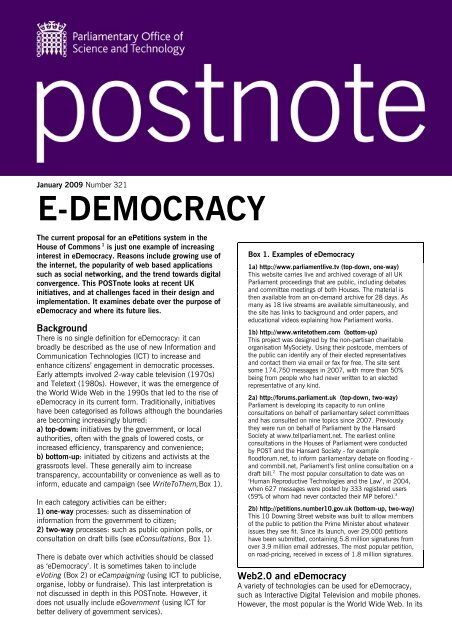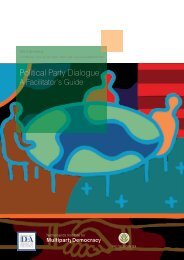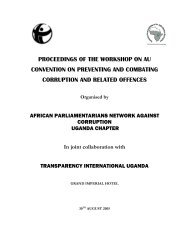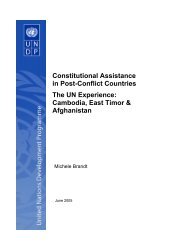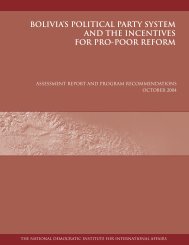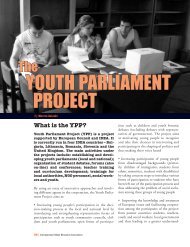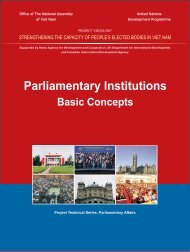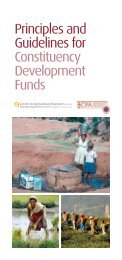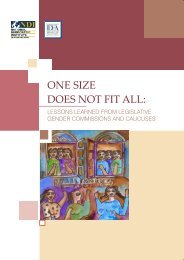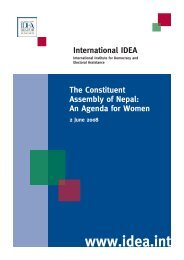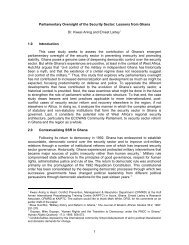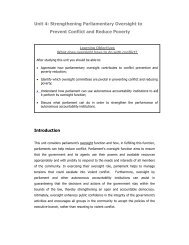E-DEMOCRACY - Parliament
E-DEMOCRACY - Parliament
E-DEMOCRACY - Parliament
- No tags were found...
Create successful ePaper yourself
Turn your PDF publications into a flip-book with our unique Google optimized e-Paper software.
January 2009 Number 321E-<strong>DEMOCRACY</strong>The current proposal for an ePetitions system in theHouse of Commons 1 is just one example of increasinginterest in eDemocracy. Reasons include growing use ofthe internet, the popularity of web based applicationssuch as social networking, and the trend towards digitalconvergence. This POSTnote looks at recent UKinitiatives, and at challenges faced in their design andimplementation. It examines debate over the purpose ofeDemocracy and where its future lies.BackgroundThere is no single definition for eDemocracy: it canbroadly be described as the use of new Information andCommunication Technologies (ICT) to increase andenhance citizens’ engagement in democratic processes.Early attempts involved 2-way cable television (1970s)and Teletext (1980s). However, it was the emergence ofthe World Wide Web in the 1990s that led to the rise ofeDemocracy in its current form. Traditionally, initiativeshave been categorised as follows although the boundariesare becoming increasingly blurred:a) top-down: initiatives by the government, or localauthorities, often with the goals of lowered costs, orincreased efficiency, transparency and convenience;b) bottom-up: initiated by citizens and activists at thegrassroots level. These generally aim to increasetransparency, accountability or convenience as well as toinform, educate and campaign (see WriteToThem,Box 1).In each category activities can be either:1) one-way processes: such as dissemination ofinformation from the government to citizen;2) two-way processes: such as public opinion polls, orconsultation on draft bills (see eConsultations, Box 1).There is debate over which activities should be classedas ‘eDemocracy’. It is sometimes taken to includeeVoting (Box 2) or eCampaigning (using ICT to publicise,organise, lobby or fundraise). This last interpretation isnot discussed in depth in this POSTnote. However, itdoes not usually include eGovernment (using ICT forbetter delivery of government services).Box 1. Examples of eDemocracy1a) http://www.parliamentlive.tv (top-down, one-way)This website carries live and archived coverage of all UK<strong>Parliament</strong> proceedings that are public, including debatesand committee meetings of both Houses. The material isthen available from an on-demand archive for 28 days. Asmany as 18 live streams are available simultaneously, andthe site has links to background and order papers, andeducational videos explaining how <strong>Parliament</strong> works.1b) http://www.writetothem.com (bottom-up)This project was designed by the non-partisan charitableorganisation MySociety. Using their postcode, members ofthe public can identify any of their elected representativesand contact them via email or fax for free. The site sentsome 174,750 messages in 2007, with more than 50%being from people who had never written to an electedrepresentative of any kind.2a) http://forums.parliament.uk (top-down, two-way)<strong>Parliament</strong> is developing its capacity to run onlineconsultations on behalf of parliamentary select committeesand has consulted on nine topics since 2007. Previouslythey were run on behalf of <strong>Parliament</strong> by the HansardSociety at www.tellparliament.net. The earliest onlineconsultations in the Houses of <strong>Parliament</strong> were conductedby POST and the Hansard Society - for examplefloodforum.net, to inform parliamentary debate on flooding -and commbill.net, <strong>Parliament</strong>’s first online consultation on adraft bill. 2 The most popular consultation to date was on‘Human Reproductive Technologies and the Law’, in 2004,when 627 messages were posted by 333 registered users(59% of whom had never contacted their MP before). 32b) http://petitions.number10.gov.uk (bottom-up, two-way)This 10 Downing Street website was built to allow membersof the public to petition the Prime Minister about whateverissues they see fit. Since its launch, over 29,000 petitionshave been submitted, containing 5.8 million signatures fromover 3.9 million email addresses. The most popular petition,on road-pricing, received in excess of 1.8 million signatures.Web2.0 and eDemocracyA variety of technologies can be used for eDemocracy,such as Interactive Digital Television and mobile phones.However, the most popular is the World Wide Web. In its
postnote January 2009 Number 321 eDemocracy Page 2early days the web focused on delivery of information,with the user as a passive consumer. However, ‘Web2.0’ applications (see Box 3) allow information sharingand peer-to-peer collaboration, for example:• Blogs (or web-logs) which usually take the form of anonline diary: such as the House of Lords’ ‘Lords of theBlog’ at http://lordsoftheblog.wordpress.com. This is apilot project of the Hansard Society aiming toencourage dialogue with the House of Lords.• Social networking sites like Facebook and YouTube(used by ~11 million UK residents a month, aboutone third of all UK internet users) 4 allow users tointeract, and share images or audio/video clips. Almost100 MPs have Facebook pages. <strong>Parliament</strong> and 10Downing Street (see Box 3) started their own YouTubechannels in 2007. A key feature is the viral nature inwhich information and commentary can propagaterapidly across the network.eDemocracy in <strong>Parliament</strong> and GovernmentIn recent years various measures have been taken by<strong>Parliament</strong> and the government, to exploit opportunitiesoffered by new ICT. Some of these are discussed below.eDemocracy in GovernmentThere is no single government department responsible foreDemocracy although a range of initiatives is under way(Boxes 1 and 3). Two key developments initiated by theCabinet Office focus on better use of public sector data,and more user-centric government services.Better Use of Public Sector DataThe independent “Power of Information” (POI) review 5commissioned by the Cabinet Office, was published inJune 2007. It highlighted the importance of public sectordata, ranging from maps to heart surgery mortalitystatistics. Online tools are emerging to handle thisinformation in new ways. The review recognised that thegovernment has a role to play in maximising the benefitsfor citizens. A key outcome of the report was the settingup of the POI taskforce, whose work is in two key areas:• Exemplars: projects that will demonstrate the POIprinciples in action, broadly in the fields of criminaljustice, health and education. In a search for‘exemplars’ the POI has run a competition for thepublic to devise better ways to use government data(www.showusabetterway.co.uk). Five ideas will betaken forward. They include a website where userscan see the boundaries of school catchment areas andone which helps users find their nearest postbox.• Enablers: for example, the publication of civil serviceguidelines on the use of social media in June 2008.Before this civil servants were impeded from bloggingor joining in online forums in a professional capacity.More User-centric Government ServicesIn 2005, the Cabinet Office’s eGovernment unit releasedits Transformational Government strategy. 6 It outlined theneed to use technology to give citizens choice, withpersonalised services designed around their needs, notthose of the provider. To this end, a policy of websiterationalisation was introduced. 712 out of 765 centralGovernment websites will close by the end of 2011.Box 2. eVotingeVoting (voting electronically) can be done either at aterminal in a polling station, or remotely. The focus here ison the latter. Pilot schemes have been trialled by localauthorities around the UK since 2000. The most recent tookplace in the May 2007 elections. Five local authoritiesexplored remote internet voting (four of these also examinedtelephone voting). To date, trials have identified concernsover reliability and security, as well as effectiveness.After evaluating the May 2007 trials, the ElectoralCommission recommended there should be “no more pilotsof electronic voting without a system of individual voterregistration” and “significant improvements in testing andimplementation”. 7 Concerns have also been expressedelsewhere in the world: the Irish Republic, the Netherlandsand the Canadian province of Quebec all have moratoria onthe further use of eVoting.The Open Rights Group is a campaigning organisationaiming to raise awareness of digital rights and civil libertiesissues. It argues that “eVoting is a ‘black box system’, wheremechanisms for recording and tabulating the vote are hiddenfrom the voter. This makes public scrutiny impossible, andleaves statutory elections open to error and fraud.” 8Evidence indicates that electronic voting does not increasevoter turnout, but proponents of eVoting point to the benefitsthat it can offer, such as making voting easier and moreaccessible to many disadvantaged groups in society such asthe elderly, disabled, or home-bound. Most critics think thatthe idea of eVoting should be dropped altogether. Othersfavour further investigation, arguing that the demand foreVoting is likely to persist as an increasing number of otherservices become remotely available.In October 2008, the Minister for Justice told <strong>Parliament</strong>that the government “had no plans to trial e-voting in the2009 European or local elections”. He said the way forwardmight be informed by “the possible further testing of e-votingsolutions in non-statutory elections”. 9Box 3. Examples of Web2.0 eDemocracyTheyWorkForYou (http://www.theyworkforyou.com)Since 2004, this MySociety website has provided asearchable, annotatable version of what is said in <strong>Parliament</strong>to over 100,000 visitors a month. 4 It aggregates contentfrom the official Hansard record, and other publicly availabledata. The site aims to provide that information in a clear andconcise way that is specific and relevant to the user. It alsoprovides information on a range of different measures ofactivities by MPs, such as parliamentary appearances andvoting patterns.10 Downing St. (http://www.youtube.com/user/downingst)Since April 2007, Number 10 has had its own YouTubechannel which has over 300 videos, half a million channelviews and over 6000 subscribers. A regular initiative hasbeen launched, called ‘Ask the PM’, where members of thepublic can upload questions for the Prime Minister, who willrespond to those that are voted most popular by theYouTube community. The channel also contains hyperlinksto the 10 Downing St webpage and the latest news fromNumber 10, as well as the new “Number 10 TV’ which willfeature exclusive video coverage of the Prime Minister’sspeeches and media appearances.
postnote January 2009 Number 321 eDemocracy Page 3eDemocracy in <strong>Parliament</strong>The first report by the Select Committee onModernisation of the House of Commons in 2004 madeseveral recommendations which triggered changes in theway <strong>Parliament</strong> uses ICT to interact with the public: 10• Upgrading <strong>Parliament</strong>’s website (www.parliament.uk).Since the report’s publication the website hasundergone major changes and now containsinformation on the structure and history of <strong>Parliament</strong>,on members and staff of both Houses, business andnews, and publications and records. It is now visitedby 280,000 people a month.• Greater use of online consultations and publicpetitions. Following on from the Committee’s report, aHouse of Commons Procedure Committee inquiry in2007 recommended introduction of an ePetitioningsystem to the House of Commons. Much of the detail,such as oversight mechanisms and costs, is still to bedecided. The government has endorsed the basicproposal and indicated that further parliamentarydebate will take place. e-petitions programmes for theScottish <strong>Parliament</strong> and Welsh Assembly werelaunched in 1999 and 2008 respectively.• The report also recommended that the possibilitiesoffered by digital broadcasting of <strong>Parliament</strong> be keptunder review. The Group on Information for thePublic 11 is moving forward with various projects suchas parliamentlive.tv (which carries live and archivedcoverage of all public proceedings) and <strong>Parliament</strong>’sown YouTube channel. Video from <strong>Parliament</strong> iscurrently prohibited from being unofficially posted onYouTube and other video streaming websites, 12 butnegotiations are underway to address this. 13Factors Affecting Uptake of eDemocracyTechnological ChallengesPrivacy and Personal DataeDemocracy initiatives can involve the submission,transmission, or storage of personal data. To build andmaintain confidence, this must be done in a securemanner. This is particularly an issue when anonymityneeds to be preserved. For example, eVoting systemsneed to be able to link any given vote to a specific personto prevent fraud. Operating in such an auditable andtransparent manner, although necessary, conflicts withthe need to preserve voters’ privacy and anonymity.Privacy is also mentioned in debate over other forms ofeDemocracy: some academic papers highlight thepotential for privacy to become an issue for eDemocracyinitiatives based around social networking websites. 14Standardisation of InformationInformation published in non-standard formats canhinder eDemocracy initiatives. For example, the websiteTheyWorkForYou.com (Box 3) does not yet cover thework of parliamentary committees because they do notuse a standard format to publish their information, whichmakes it very difficult to process. 15User-centric DesignThis term refers to websites (or other products) whosedesign is centred on the needs and behaviour patterns oftheir users. This covers not just the quality and relevanceof a site’s content but also how accessible and easy it isto use. Proponents argue that this ethos is behind thesuccess of many eDemocracy initiatives, and that it isone reason why websites such as YouTube and Facebookare visited more often than many official websites.Open Source Software (OSS) 16This is a software development methodology where aprogram’s source code is made available for modificationas users, and other developers, see fit. Through thistransparency of process, OSS can provide “better quality,higher reliability, more flexibility and a lower cost.” 17 Thesoftware engines behind 10 Downing Street’s ePetitionssite, PublicWhip.org and TheyWorkForYou.com are allOSS and freely available for use by others. This keepscosts down by avoiding ‘re-inventing the wheel’, andallows developers to learn from previous experiences.The Data ‘Mashup’There is widespread interest in the concept of the data‘mashup’, a web application that takes data frommultiple sources, and combines them into a singleintegrated tool such as theyworkforyou.com (Box 3). Thisaggregates content from the official Hansard records andpresents it to a user in a new format. The Cabinet OfficeMinister for Transformational Government has advocatedthe use of mashups by all departments.Social Challenges: the Demographics of eDemocracyThere is debate over whether eDemocracy initiatives riskalienating those who lack either physical access to ICT orthe skills to use them. For example, internet usage tendsto be dominated by the young, educated, wealthy andable-bodied. 18 Only 36% of disabled people use theinternet as opposed to some 77% of those who are nondisabled.18 Also, although internet use has increasedacross nearly every income and age bracket in the last 2years, uptake is levelling off and still only 66% of thepopulation have internet access. 18Some say this may prevent eDemocracy becoming auseful tool for the whole of society. However others saythat even without universal access, there are benefits tosociety as a whole. For example, the Director of theOxford Internet Institute argues that one of the keypurposes of eDemocracy is to increase accountability,which does not require participation from the whole ofsociety. Providing people with the technology and skillsrequired to participate in eDemocracy will not increasetheir engagement automatically. Although young peopleare among the most technologically literate, they are alsoamongst the least engaged in politics. Tackling thisdisengagement is often considered more pressing thanincreasing technological access.How Effective is eDemocracy?EvaluationIt is widely argued that more rigorous post-projectevaluation is needed for eDemocracy initiatives, so thattheir impacts can be better understood. One example isthe 10 Downing Street ePetitions initiative. ePetition
postnote January 2009 Number 321 eDemocracy Page 4signatories are identified via their email address, of whichthey may have many. This can make it hard to judge thetrue significance of an ePetition as the number of distinctparticipants is unknown. Also, no data are beingcollected on the demographics and backgrounds of theePetition signatories on the Downing Street website,which some argue makes it difficult to learn from theinitiative.Meeting Expectations of ParticipantsProponents of eDemocracy say well-designed initiativescan be used to re-engage and interest disenfranchisedgroups. However there is a risk that even if citizensengage in an initiative, they may be disillusioned if theoutcome does not match their expectations. Forexample, with the 10 Downing Street petition modelthere is no onus to pursue any particular petition topicfurther. The director of the eDemocracy programme atthe Hansard Society argues that “this could lead tocitizens becoming disillusioned because petitions are nottaken further, possibly further detaching themselves fromthe political process.” One of the main recommendationsof the proposed House of Commons petitions system isthat some petitions would be chosen for select committeescrutiny or debate in <strong>Parliament</strong>.Box 4. Shoreditch TVTrialled by around 900 users, ShoreditchTV was aShoreditch Trust funded pilot project to provide interactivecontent through an IPTV (Internet Protocol Television) setup.The main goal of the project was to investigate new ways todeliver services while helping to build community capacityskills. It was implemented by Digital Bridge (as part ofTwofour, the company responsible for parliamentlive.tv andthe EU equivalent EuroparlTV).The project offered a ‘Community Safety Channel’ whichgave residents the chance to monitor local CCTV cameras,view a ‘usual suspects’ ASBO line-up, and receivecommunity safety alerts. Other channels offered theopportunity to report crimes such as dumping, graffiti andabandoned cars. When surveyed, some 70% of usersclaimed to have reported incidents while only 8% said theywould have normally reported them via other means.The Future of eDemocracyeDemocracy is still evolving. Almost all the UKpopulation have mobile phones, 66% have internetaccess and 98.5% of the UK will receive digital TVservices by 2012. 19 The line that divides the functions ofthese platforms is becoming increasingly blurred. Thistechnological convergence will provide new opportunitiesfor delivering eDemocracy in the coming years.There is a wide range of views over what eDemocracy isand where its future lies. At its simplest level, it can beseen as a tool to bring democracy and political processesin line with technological developments. Beyond that, itcould be seen as a way to strengthen existing politicalprocesses, by increasing interaction between citizen andthe government. The Institute for Public Policy Researchsays that eDemocracy is about “encouraging people tointeract on a neighbourhood level to solve theirproblems” (see Box 4). Wherever its future lies, it iswidely agreed that eDemocracy should be used tocomplement other methods of engagement, rather thanto replace them.Overview• eDemocracy can be described as the use of new ICT toincrease and enhance citizens’ engagement indemocratic processes.• However, even if people have access to the technologyand the skills needed to participate in eDemocracy,they will not automatically engage in it. Tacklingdisengagement is often considered more pressing thanincreasing technological access.• More rigorous evaluation is needed for eDemocracyinitiatives, so that their impacts can be fullyunderstood. In some cases, identification ofparticipants is necessary to understand thesignificance of results, but this may raise privacyissues.Endnotes1 Procedure Committee, First Report of Session 2007-08, e-Petitions,HC 1362 For further information see www.democracyforum.org.uk3 Tell<strong>Parliament</strong>.net Evaluation Report, Hansard Society, October 20064 Nielsen Online data (May 2008)5 The Power of Information: An Independent Review, Ed Mayo andTom Steinberg, June 20076 Transformational Government, Enabled by Technology, CM6683,November 20057 Key Issues and Conclusions – May 2007 Electoral Pilot Schemes,Electoral Commission, August 20078 May 2007 Election Report, Open Rights Group, June 20079 HC Deb, 23 October 2008, col 559W10 Modernisation Committee, First Report of Session 2003-04,Modernisation of the House of Commons11 The Group on Information for the Public (GIP), made up of officialsfrom both Houses of <strong>Parliament</strong>, is responsible for planning,developing, reviewing and coordinating the provision of informationto the public.12 Early Day Motion 159, YouTube and social responsibility, 8 thNovember 2007.13 Engaging the Public: Business Plan 2007-08, Group onInformation for the Public (GIP), May 200714 David Wills and Stuart Reeves, “Facebook as a political weapon:explicit and implicit information in social networks”, In proceedingsof Towards a Social Science of Web 2.0, September 200715 Minutes of Evidence, Public Administration, 8th March 200716 Open Source Software, POSTnote 242, <strong>Parliament</strong>ary Office ofScience and Technology, June 200517 The Open Source Initiative: http://www.opensource.org18 The Internet in Britain 2007, Oxford Internet Institute, 200719 Analogue to Digital TV Switchover, POSTnote 264, <strong>Parliament</strong>aryOffice of Science and Technology, June 2006POST is an office of both Houses of <strong>Parliament</strong>, charged with providingindependent and balanced analysis of public policy issues that have a basis inscience and technology.POST is grateful to William Fletcher for researching this briefing, to the EPSRC forfunding his <strong>Parliament</strong>ary fellowship, and to all contributors and reviewers. Forfurther information on this subject, please contact Dr. Chandrika Nath, at POST.<strong>Parliament</strong>ary Copyright 2009The <strong>Parliament</strong>ary Office of Science and Technology, 7 Millbank, London,SW1P 3JA; Tel: 020 7219 2840; email: post@parliament.ukwww.parliament.uk/parliamentary_offices/post/pubs2009.cfm


